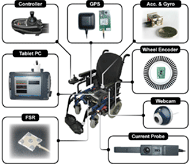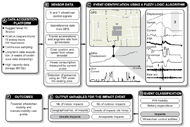Ecological Measurement of Powered Wheelchair Mobility and Driving Performance using Event-driven Identification and Classification Methods
Patrick Boissy1-2 , PhD, Mathieu Hamel1, PEng, MSc, Philippe Archambault3 , OT(C), PhD, and François Routhier4-5 , PEng, PhD
1-Research Centre on Aging, Sherbrooke, Canada, 2-Dept. Kinesiology, Sherbrooke University, 3-School of Physical & Occupational Therapy, McGill University, 4-Montréal Geriatric University Institute, Research Centre; 5-Dalhousie University, Physical Medicine and Rehabilitation.
ABSTRACT
This paper proposes a measurement approach to characterize, under real life conditions, powered wheelchair (PW) mobility and driving performance. Our approach, under development, combines data logging of multiple sensor sources over long periods of time, and event identification and classification methods based on fuzzy logic to establish the mobility and driving performance profile of PW users. Initial experiments with a prototype system are reported and the results demonstrate the feasibility of identifying events such as unsafe collisions using the accelerometer data. The long term vision of this project is then discussed. It is expected that our PW monitoring system will facilitate, through individualized skill training and personalized adjustments, the use and impact of PW in people with locomotor impairments.
KEYWORDS
Powered wheelchair, wheeled mobility, ecological settings, monitoring system, event identification.
BACKGROUND
Mobility is an important factor for the social participation and quality of life of individuals. For people who live with locomotor impairments, optimal use of assistive devices such as wheelchair can facilitate mobility [1, 2]. To improve manual or powered wheelchair skills, but also wheelchair design in terms of safety and performance, a better characterization of wheelchair users’ driving behavior is required, in various real and ecological indoor and outdoor settings. While monitoring systems for manual wheelchair users have been proposed [3, 4], none currently exists for powered wheelchair (PW) users. PW use can be observed from a “macroscopic” point of view, i.e. the distance traveled, the mean speed, and the position in the environment. It can however also be seen from a “microscopic” perspective, i.e. the user’s behavior during a key event or immediately preceding it, such as striking a wall, rolling over a door threshold, overcoming a pothole and ascending a slope. The purpose of this project is to develop a monitoring system that can take into consideration both level of analysis to characterize mobility and driving performance of PW users.
RESEARCH OBJECTIVES
The long term vision of this project is: 1) to develop and validate an innovative research methodology that is appropriate for use in community-based research on various aspects of PW use, 2) to provide insights from the ecological use of PWs in order to establish guidelines for PW design and prescription, and ultimately 3) to provide monitoring tools to facilitate and optimize, through individualized skills training and personalized adjustments of PW features, the use and impact of PW in people with locomotor impairments. This paper presents an overview of the monitoring system, some validation data and the planned analyses of the collected signals.
METHOD AND RESULTS
The proposed approach is based on analytical methods developed previously on fall detection and activity monitoring using wearable sensors and artificial intelligence [5, 6]. The application of this methodology to PW monitoring is under development and the proof-of-concept for its use is ongoing. A monitoring system comprised of multiple sensors connected to a tablet PC (Iotronix) through a 16 channels A/D card (National Instrument DaqCard 6024E) is used to record data continuously from the PW (Figure 1). The sensors used in the monitoring system consist of two 2g tri-axial accelerometers positioned in the front and rear of the PW; one 2 axis gyroscope positioned in the rear of the PW; a 16 signals GPS receiver, an optical wheel encoder positioned on one of the rear wheel of the PW; a current probe connected to the power source of the wheelchair; X and Y command signals from the wheelchair controller, an force sensitive resistor positioned under the seat of the PW and finally a webcam streaming video at 4 frames per second. The webcam will be used as a confirmatory measure for the field testing of the identification and classification methods (see below). Sensors are powered by the A/D card. The tablet PC is connected to the power source of the wheelchair, and it runs a dedicated data acquisition software (Labview) that samples the data from the sensors at 250 Hz and stores them on the Tablet PC. Data are segmented as individual 8 minutes recordings. The time limit of the data acquisition is dependent on hard drive space (60 Gb) and conditional on the availability of power from the PW battery to the Tablet PC. Preliminary tests show a theoretical autonomy of >4 weeks of continuous recordings (Storage rate: 1 Mb/min or 10 Gb/week). The total estimated price of the system is approximately $5,500 (CDN) with 2/3 of the cost associated with the data acquisition platform used.
Recordings from the sensors are processed off-line using fuzzy logic algorithms to identify events and classify them. The proposed event driven identification and classification methods are illustrated in Figure 2 by mean of an example involving an unsafe impact detected on the wheelchair. Long-term data acquisition (days of sensor data) is segmented (Box A) and fed to a fuzzy logic algorithm (Box B). Each event consists in a fuzzy inference system (FIS) with sensor data as inputs and a level of classification as output. In Box C, data from all sensors are fed to the FIS, which will detect the presence of an impact by using the front and rear accelerometers (section 1). By combining these signals with the control input from the user at the moment of impact (section 2) and the resulting speed of the chair (i.e. after impact) (section 3), the FIS can generate two classifier outputs indicating the percentage of detection of the impact and a level of safeness on scales ranging from 0 to 10. From these scales, it is possible to classify this particular event as an “Impact” (Box D) and further as an “Unsafe impact” (Box E) considering the speed of the wheelchair at impact and the effect on the wheelchair. The same approach can be used to detect other types of events. For example, the combination of the GPS positioning, PW displacement and speed can generate navigation events. Those events can further be detailed as time spent on an inclined surface, time spent at high speed or simply time spent indoors or outdoors. By summing the output variables, it is possible to establish over the recording period the profile of mobility (e.g. time and distance used indoors, outdoors, distance and location of travel from a point of reference, power consumption, etc.) as well as driving performance of the user (e.g. number of unsafe impacts) (Box F).
DISCUSSION
The preliminary results obtained with our PW monitoring system have highlighted the feasibility of recording driving behavior in ecological situations and of extracting pertinent information from this data, related to PW mobility and driving performance. In future experiments, we plan to expand and validate the event identification and classification strategy, in order to draw a complete wheelchair users’ behavior profile. This research will be accomplished by the following steps:
- Characterization of PW use in a controlled environment
- In this first step, healthy subjects will drive the instrumented wheelchair in a controlled laboratory environment, such as suggested in the Wheelchair Skills Program (www.wheelchairskillsprogram.ca) and accomplish specific tasks related to each of the events: collisions against solid surfaces at different speeds, maneuvering around obstacles and out of tight spaces, driving over steps of different heights, uneven surfaces and inclined planes. The purpose is to gather a database of sensors signals recorded during known events to optimize the fuzzy inference systems used to identify and classify events used to characterize PW mobility and driving performance.
- Characterization of PW use in an ecological setting
- In this step, the project will move from the laboratory to various inside and outside settings. Healthy subjects will be asked to drive the instrumented PW for a two-hour long run, where they will be asked to accomplish specific goals around a familiar environment (e.g. drop a book at the library, deliver a message, etc.). This obstacle course will also involve a variety of settings, such as indoors and outdoors area, crowded places, sidewalks and elevators. An observer will follow the subject to note the occurrence of each event we wish to identify. The fuzzy logic algorithms developed in the laboratory will be tested against the data collected in the outside world and validated against the observations made during the experiments. Adjustments to the algorithms will be made if necessary.
- Optimization of PW monitoring system for field testing of long term monitoring PW use
- In order to gather data in ecological setting across multiple users with different PW model for long periods of time, the PW monitoring system will be optimized. The data acquisition system (Tablet PC with A/D card) will be replaced by a passive data logger to decrease cost. The sensor package will be revised so that it can be easily installed on any PW.
- Long term monitoring of wheelchair driving behavior
- For this part, multiple PW users (n=25) will be required to use the instrumented PW in their daily lives, for over a 30-day period. PW mobility and driving performance profiles will be established and compared to a battery of outcome measures to explore the validity of the proposed approach.
CONCLUSION
Our wheelchair-monitoring platform, combined with our ecological analysis of behavior will permit the direct comparison of wheelchair usage both at the macroscopic and microscopic levels. Thus, it will be possible to link together measures related to global outcomes and driving performance (mean driving speed, distance traveled, etc) with behavior in specifically identified events, such as collisions, maneuvering in tight corners or driving on inclined surfaces. These insights will further our understanding of the interrelationship between dependence, task modification, and reported difficulties associated with PW. Our approach will be beneficial to users and therapists, by leading to better rehabilitation programs, such as PW skills training that can specifically address the needs of a particular user. By providing data on wheelchair usage and driving behavior, the results from this project will also be of great use to wheelchair manufacturers, as well as public and private funding agencies.
REFERENCES
- Pettersson I, Ahlström G, Törnquist K. (2007). The value of an outdoor powered wheelchair with regard to the quality of life of persons with stroke: a follow-up study. Assist Technol 19(3):143-53.
- Chaves, E, Boninger, M, Cooper, R et al. (004). Assessing the influence of wheelchair technology on perception of participation in spinal cord injury, Arch Physical Med Rehabil 85(11):1854-8.
- Ding D, Leister E, Cooper RA et al. (2005). A wheelchair usage monitoring/logging system. Conf Proc IEEE Eng Med Biol Soc 7:6897-9.
- Spaeth, DM, Cooper RA, Albright, S et al. (2004). Development of a miniature data logger for collecting outcome measures for wheeled mobility. RESNA 2004 - 27th International Conference on Technology & Disability: Research, Design and Practice. Orlando, FL, USA. June 18-22.
- Boissy, P, Choquette, S, Hamel, M and Noury, N. (2007). User-based motion sensing and fuzzy logic for automated fall detection in older adults. Telemed J E Health 13(6):683-94.
- Boissy, P, Hester, T, Sherrill, D et al. (2007). Monitoring mobility assistive device use in post-stroke patients. Conf Proc IEEE Eng Med Biol Soc 1:4372-5.
Author Contact Information:
Patrick.Boissy@usherbrooke.ca
Research Centre on Aging
CSSS-IUGS
1036 Belvédère Sud
(819) 821-1170 ext. 2628
Sherbrooke (Québec), CANADA, J1H 4C4

